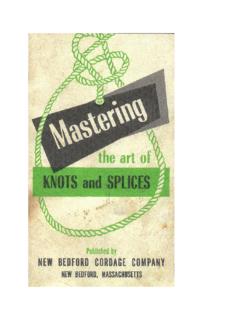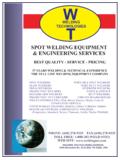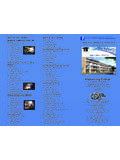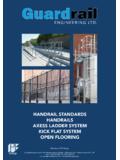Transcription of Scout Engineering - Pioneering Projects
1 1 ScoutEngineeringSCOUT ENGINEERING2 Getting startedPioneering or Scout Engineering refers tothe work of military engineers who wentahead of the army on foot, to buildbridges, roads and to generally preparethe got there first, often in thewilderness, and had to make do withwhat they could find, or carry. With axesand ropes they worked wonders andcreated many functional Scouting we carry on this tradition as itprovides Patrols with a challenge and anopportunity to develop as a team andachieve something building it is necessary to have anunderstanding of the skills involved aswell as enthusiam. Firstly, it isnecessary to know how to tie therequired knots and lashings, secondly,you must have spars or poles fromwhich to build your project.
2 The nextconsideration is ropes and pulleys tobridge and secure your project and lastlysome know how and loads of project should be approached in alogical way:-What are we trying to doWhat equipment do we haveWhat is the best way to use thisequipmentDesigning the projectPlanning the steps to complete theprojectTesting and safetyDismantling the projectEvery project should be approached in thisway. The designs suggested are tried andtested however you rarely find a level riverbed or trees in the right places for ropebridges etc. so each of the basic designssuggested will have to be modified to suit theconditions you Pioneering structure are createdusing a number of basic forms -the A frame, the A frame with doublebar, the sheer legs, the square trestle and the rectangular of these basic structures arestable if constructed properly and will notmove out of the basic shapes are constructed onthe ground they are combined perhaps with anumber of linking spars to provide a tower,bridge or similar structure.
3 As a general ruleit is better to build a big structure from anumber of smaller and reasonably lightframes rather than try to lift heavy frames would suggest thatthe best lashing to use in theconstruction of the Projects isnot the traditional squarelashing but rather theNorwegian lashing which iseasier and quicker to tie thanthe traditional the Norwegian lashingthe sisal or lashing rope ishalved and you are constantlypulling the strain againstyourself which makes it easierto tighten and manage theconstruction of the lashing plusyou finish it off with a reef knotor granny knot which ever iseasiest. Once you master thetechnique it can be adapted tothe other lashings - Tripod,Diagonal, ENGINEERING4 RopesRopes come in many types and sizes and to simplifymatters you should use the following as a rope (25 mm diameter) or larger, certainly nosmaller than 75mm, should be used whenever it is intended to holdweight such as in the case of a monkey bridge - foot and hand rails,aerial runways, and commando rope mm rope (16 mm diameter) should be used for reeving up pulleysand anchors and for rope rope (8mm diametere)
4 Should be used for guy ropes in general,on large structures this size would need to be reference - the size of a broom handle is mm reference - the size of a man s thumbr is diameterQuick reference - the size of a index finger what is known assash cord or heavy cloths lenghts will vary according to howthey are purchased, 25 metre lenghts willnormally cover most Projects as thedistance between sheer legs or ropebridges should not exceed 15 metres toavoid flipover . Flipover occurs when theslack in the rope is such that it acts muchlike a skipping rope, when pressure isapplied to the middle of the rope itbecomes unstable and sways resulting inthrowing off the rope crosser orentangling them in the ropes, which isextremely most of the ropes used in pioneeringstructures require an element of friction toprovide maximum efficiency, hawser laidropes of natural fibre such as sisal or hempare preferred, but they are more expensiveand need care and attention as the fibres canrot and deteriorate if not dried ropes are cheap but require extracare particularly when fixing the ropes totrees and poles.
5 The ropes are generallysmoother than hemp or sisal ropes and theknots have a tendency to slip underpressure. To ensure safety and preventslippage you should secure all knots withextra below this sizeshould be used forlashings onlySimple wooden ropesize guage5 Coiling a RopeWhen coiling a heavy hawser it is best tocoil it in large loops on the ground. Passingthe hawser through your legs will aid thisprocess and prevent tangling. The coil isecured using short sisal tiesIn order to protect a rope from damage and toaid in transporting it, you need to be able tocoil a rope properly. This can be done in anumber of ways as shown. When coiling letthe rope fall into natural loops.
6 In order for thisto happen it will be necessary to flick andturn the rope. Once completed the coil issecured by a whipping type knot or via aloop ENGINEERING6 PulleysMost Pioneering Projects can becompleted using 2 pulleys - a singleblock and a double block. However, it isbest to aim for 2 single blocks and 2double blocks and perhaps a number ofsmall blocks - the ones used forclothsline and sailing. This will allow youto complete most Projects you willventure to you are in possession of a hooked block it cannot beused by the hook alone. All hooked blocks need to be moused . This is done using sisal which is boundaround the bill and back of the hook as is not 100% effective so it should be checkedat regular intervals when in use on a size of your blocks will need to be;-150mm for 50mm rope230mm for 75mm ropeBy employing single and doublepulleys different pull ratios can beachieved7 Fix line to pulley using a roundturn and two half hitches.
7 It is alsoa good idea to whip the free end ofthe line to prevent slippage. Youcan also use a stopper knot if youwish to do the same knotThis knot is used to connect aline to a hooked pully you are using aclosed eye pulley itmaybe necessary touse a D ring shackleto allow you to attacha heavy a simplesingle and doublepulley systemSCOUT ENGINEERING8 AnchorageIf at all possible you should anchor yourropes to a fixed object such as a big treeor rock. However, they are rarelyavailable in the right places so we haveto create our own anchors. There are twopossibilities the 3-2-1 picket and the picketand log anchor. Both are illustrated below,in each case the pickets should be atleast 160cms long and put in position witha sledge hammer or large mallet.
8 If theground is soft they may need to belonger. The pickets should be set in theground at 60 degrees and the bindingsbetween pickets should always run fromthe top of one picket to the bottom of a rule of thumbPickets should be positioned in theground approx. 3 times the height fromwhich the main rope leaves the if the main rope passes over thesheer legs at 3 metres above the groundthen the pickets should be set in theground 9 meters from the base of thesheer would be normal practice to fix the ropeto a log and picket anchor and fix thepulley assembly to a 3-2-1 picket anchorsWith fixed anchors, such as trees, you needto create a loop of rope on which to fixpulleys.
9 This is done by wrapping a ropearound a tree a number of times as collective strenght of the loops of ropemust exceed the strength of the rope beingstrained otherwise the loops are the weakestpart of the structure. It is therefore suggestedthat 25mm rope is used for this job and iswound around the tree at least 4 of treesIf you are fixing a rope or spar you shouldbe careful not to damage the bark. This canbe done by using some sacking or oldcanvas to protect the bark from may also be necessary to use sacking orpadding on a structure if the rope will besubject to excessive friction, particularly inthe case of a monkey bridge. this isparticularly important when using syntheticropes as they are prone to melt if in a frictionsituation or if two ropes are rubbing off picketDeadmans AnchorLog and picket anchorSCOUT ENGINEERING10 Getting upA problem that can be encountered whenpioneering is getting up a tree to secureropes and pulleys to branchesPrusik KnotThe prusik knot is a friction knot whichallows it to slid on a rope when free of aload but will grip the rope when understrain.
10 To climb a rope you will need threeprusik loops fixed onto the main rope - 2for the feet and 1 as an underarm rope is climbed by sliding the knots,one at a time, so that it is possible to stepup the rope using the foot loops. Withpractice a rhythm can be developedwhich will allow you to climb the ropewith laddersRope ladders are constructed using theMarline hitch or Clove much equipmentdo you needIn order to undertake all of the projectsshown in this chapter you need to have thefollowing minimum quanties of equipment inyour store. The quantity listed is to completeone project at a Units have a stock of spars andpulleys so it is only necessary to borrowthem from the Unit quartermaster.








